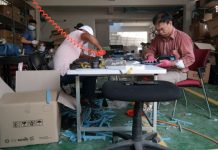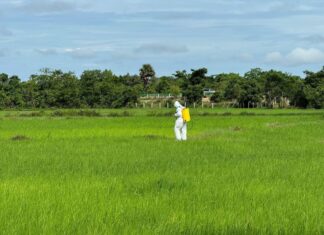រយៈពេល៥ខែ ឆ្នាំ២០២០ អាជ្ញាធរបង្ក្រាបគ្រឿងញៀនបានជាង៤ពាន់ករណី
អាជ្ញាធរបង្ក្រាបបទល្មើសគ្រឿងញៀនបានជាង៤,០០០ករណី ក្នុងរយៈពេល៥ខែដំបូង នៅដើមឆ្នាំ២០២០ ដោយចំនួននេះកើនឡើងជិត១២០០ករណី បើប្រៀបធៀបនឹងរយះពេលដូចគ្នាក្នុងឆ្នាំ២០១៩។ នេះបើតាមបញ្ជាក់របស់ប្រធានអាជ្ញាធរជាតិប្រយុទ្ធប្រឆាំងគ្រឿងញៀន។
About 30 Percent of Schoolchildren No Longer Studying Since Coronavirus School Closures: Education Minister
Since the closure of schools due to coronavirus, about 30 percent of more than 3 million students nationwide have missed out on their education because they don’t have the technology to access online learning, Education Minister Hang Chuon Naron said on Monday.
Many in Cambodia Have Stopped Wearing Masks, Saying Coronavirus Danger Has Passed
Fewer people are wearing masks in Phnom Penh and elsewhere in recent weeks despite new cases of coronavirus in the country, with residents saying they feel the danger has passed and that the masks are too uncomfortable and hot.
សហគមន៍ចាប៉ីមួយបើកបង្រៀនចាប៉ីដងវែងដោយឥតគិតថ្លៃដើម្បីជំរុញឲ្យមានការថែររក្សា និងការពារ
សហគមន៍ចាប៉ីមួយប្រកាសបើកបង្រៀនចាប៉ីដងវែងដោយឥតគិតថ្លៃដល់កុមារ និងយុវជន ដើម្បីជំរុញឲ្យមានអ្នកបន្តវេនក្នុងការថែររក្សាមរតកវប្បធម៌អរូបីមួយនេះ។
សិស្ស៣០%មិនបានរៀនក្រោយបិទសាលាក្នុងអំឡុងជំងឺកូវីដ១៩
រដ្ឋមន្រ្តីក្រសួងអប់រំកាលពីថ្ងៃចន្ទបញ្ជាក់ថា ក្នុងអំឡុងការបិទសាលាដោយសារជំងឺកូវីដ១៩ សិស្សប្រមាណជា៣០ភាគរយ នៃសិស្សជាងបីលាននាក់ មិនបានសិក្សា និង៧០ភាគរយទៀតបានសិក្សាតាមអនឡាញ និងស្វ័យសិក្សា តែមិនពេញលេញ។
ដំណឹងជ្រើសរើសបុគ្គលិកបានធ្លាក់ចុះ៨០%ក្នុងអំឡុងពេលជំងឺកូវីដ១៩
សិក្ខាសាលាមួយដែលរៀបចំឡើងដោយអង្គការ UNDP កាលពីថ្ងៃសៅរ៍ រកឃើញថា យុវជននៅប្រទេសកម្ពុជាគួរតែស្វែងរកការធ្វើកម្មសិក្សា ខណៈដែលឱកាសការងារបានធ្លាក់ចុះ៨០ភាគរយក្នុងទីផ្សារការងារអំឡុងពេលកើតមានជំងឺកូវីដ១៩។
Internet Traffic to Yoga Videos Rises Amid Coronavirus
A Cambodian producer of online yoga videos says people here have been watching more exercise tutorials online since the coronavirus outbreak, with the number of views on her channel surging this year.
ក្រុមហ៊ុនស៊ិនទ្រីប្រកាសថាបរិមាណសំរាមប្លាស្ទិកស្ថិតក្នុងកម្រិតប្រកាសអាសន្ន
ក្រុមហ៊ុនប្រមូលសំរាមស៊ីនទ្រីនៅសប្តាហ៍នេះបញ្ជាក់ថា បរិមាណសំរាមប្លាស្ទិកដែលត្រូវបានបោះចោលនៅរាជធានីភ្នំពេញ កំពុងឈានដល់កម្រិតប្រកាសអាសន្ន និងបានអំពាវនាវឲ្យប្រជាជនញែកសំរាមតាមផ្នែក ហើយអាជ្ញាធរដែលពាក់ព័ន្ធបន្ថែមការលើកកម្ពស់ការយល់ដឹងរបស់ប្រជាពលរដ្ឋ។
ព្រះអាទិត្យ និងអ្នកសារព័ត៌មាន
ព្រះអាទិត្យតែងតែរះនៅពេលព្រឹក ហើយលិចទៅវិញនៅពេលរសៀល គ្មាននរណាម្នាក់ដែលអាចឃាត់បានទេ។ វាជាដំណើរធម្មជាតិ ឬយើងអាចនិយាយបានថាជាតួនាទីរបស់ព្រះអាទិត្យ ដែលធម្មជាតិ បានបង្កើតមក ។ ម្យ៉ាងវិញទៀតភាពស្រស់ស្អាតរបស់ ព្រះអាទិត្យនៅពេលជិតអស្តង្គត ក៏បានទាញយកចំណាប់អារម្មណ៍របស់មនុស្សជាទូទៅ ផងដែរ។
Online Education During the Covid-19 Pandemic
Coronaviruses are zoonotic, meaning they are transmitted between animals and people. On Dec. 31, the World Health Organization (WHO) was alerted to several cases of pneumonia in Wuhan City, in China’s Hubei province. The virus did not match any other known virus.
Job Vacancies Fall 80 Percent Amid Coronavirus, Official Says; Youth Advised to Take Internships
Young people in Cambodia should look for internships as job vacancies have plunged 80 percent in a coronavirus-afflicted market, a U.N.-organized workshop heard on Saturday.
អតីតពលករចំណាកស្រុកនាំចូលផលិតផលដែលធ្លាប់បានផលិតនៅក្រៅប្រទេស មកលក់នៅកម្ពុជា
កាលពីប្រាំមួយឆ្នាំមុន លោក ឡាត់ សុផល គឺជាពលករចំណាកស្រុកម្នាក់ដែលធ្វើជាកម្មករដំឡើងកៅអីការិយាល័យក្នុងរោងចក្រមួយនៅប្រទេសកូរ៉េខាងត្បូង។ លោកបានត្រឡប់មកកម្ពុជាកាលពីឆ្នាំ២០១៤ ហើយបច្ចុប្បន្នលោកបានចាប់ដៃគូជាមួយបណ្តាសហគ្រាសធំៗរបស់កូរ៉េខាងត្បូង ដើម្បីនាំចូល និងដំឡើងកៅអីនៅក្នុងប្រទេសកម្ពុជា។
យុវជនមួយក្រុមគ្រោងជិះស៊ីក្លូ ពីភ្នំពេញទៅសៀមរាប ដើម្បីប្រមូលថវិកាជូនអ្នកធាក់ស៊ីក្លូ
យុវជនមួយក្រុមគ្រោងធាក់ស៊ីក្លូពី ទីក្រុងភ្នំពេញទៅកាន់ខេត្តសៀមរាប ដើម្បីប្រមូលថវិកាផ្តល់ឲ្យអ្នកធាក់ស៊ីក្លូ និងជំរុញឲ្យប្រជាពលរដ្ឋចូលរួមគាំទ្រជិះស៊ីក្លូ ព្រមទាំងអភិរក្ស។
Cintri Raises Alarm Over Excessive Plastic Trash
Phnom Penh’s waste collector Cintri said this week that the amount of plastic trash being thrown out in the city was reaching “an alarming level,” overwhelming its staff, and called for residents to separate their trash and authorities to promote greater awareness.
From Factory Hand to Businessman: Ex-Migrant Laborer Now Imports Products He Once Produced Abroad
Lat Sophal has seen his life transformed: six years ago, he was a migrant laborer in South Korea making office chairs in factories. Today, he partners with some of those same South Korean conglomerates to import and assemble the chairs here.
អាជ្ញាធរខេត្តកោះកុងប្រគល់ កង់១០គ្រឿងវិញដល់ក្រុមសកម្មជនបរិស្ថាន
អាជ្ញាធរខេត្តកោះកុង បានប្រគល់កង់ឲ្យក្រុមសកម្មជនបរិស្ថានវិញបន្ទាប់ពីឃាត់ទុកអស់រយៈពេលជិត១សប្តាហ៍កន្លងមក ប៉ុន្តែពួកគេមានការខកចិត្តដែលអាជ្ញាធររារាំងពួកគេក្នុងការដាក់ញ្ញត្តិ នៅខុទ្ទកាល័យនាយករដ្ឋមន្ត្រី។
























